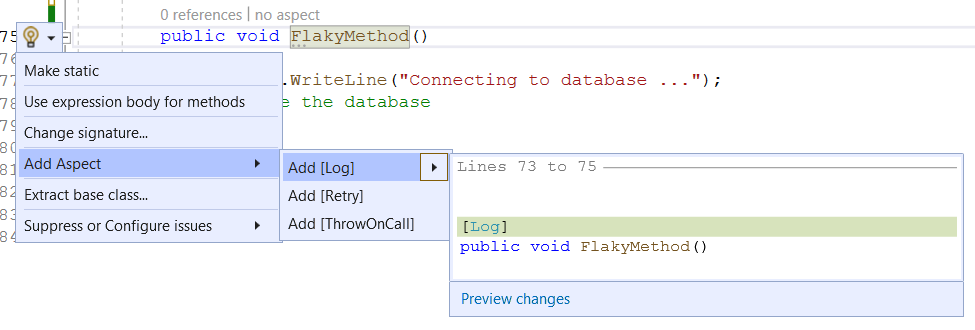Aspects are custom attributes that should be applied to a target declaration. Some aspects can target methods, while others can target properties or classes.
In this section, you will learn how to utilize custom attributes to add aspects.
Adding aspects as custom attributes
Let's assume you have a method that fails occasionally.

Currently, CodeLens displays No aspect, indicating that no aspect has been applied to this method.
Note
The CodeLens feature is only available in Visual Studio when Visual Studio Tools for Metalama are installed.
To apply the Retry aspect, add it as a standard custom attribute by typing [Retry]:

CodeLens now displays 1 aspect. Hovering your cursor over that text will reveal the following tooltip:

To view the details, click on the text 1 aspect:

The details displayed in this example are trivial. However, this feature can be quite useful when you have several aspects on the same method, or when aspects are implicitly applied rather than explicitly applied using a custom attribute.
Adding more than one attribute
You can add as many aspects as you need to a target method. In this example, if you want to log each retry attempt, you can use the Log aspect.

CodeLens now shows that two aspects have been applied to the method FlakyMethod. Clicking on the text 2 aspects allows you to view the details provided by CodeLens:

Adding aspects via the refactoring menu
Instead of manually adding attributes, you can add them via the refactoring menu. This menu can be accessed by clicking on the lightbulb or screwdriver icon, or by pressing Ctrl + ..

As shown, the refactoring menu displays three different aspects that can be applied to this method. Hovering over a menu item will present a preview of your code with the aspect custom attribute.
The refactoring menu is smart enough to recognize which aspect has already been applied and adjusts the recommendations accordingly. The following screenshot shows that after applying the Retry aspect, the refactoring menu only displays the available but unused aspects.

Note
The refactoring menu only displays aspects that are eligible for your code. The eligibility of an aspect is determined by the aspect's author. For example, it wouldn't make sense to add a caching aspect to a method returning void, so the author of this aspect might make it eligible for non-void methods only.
